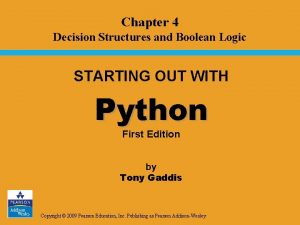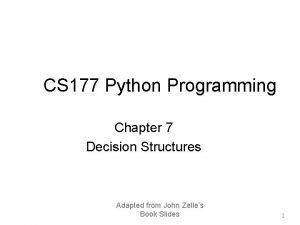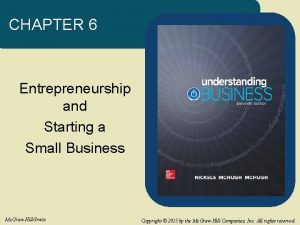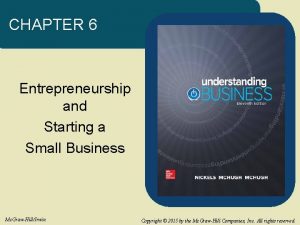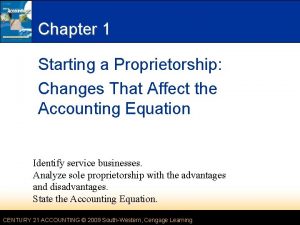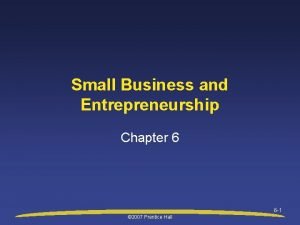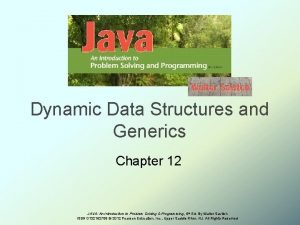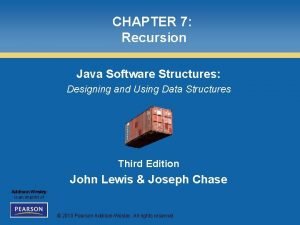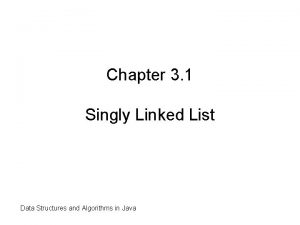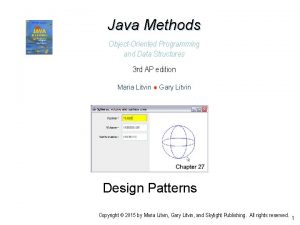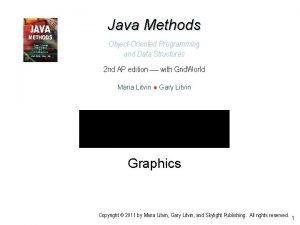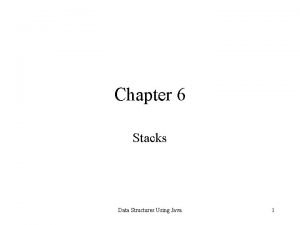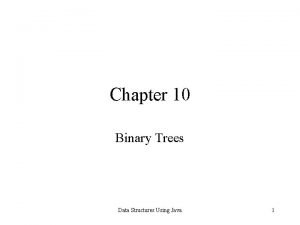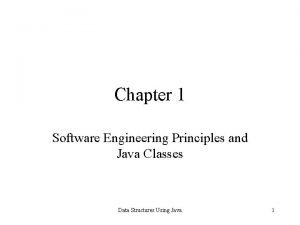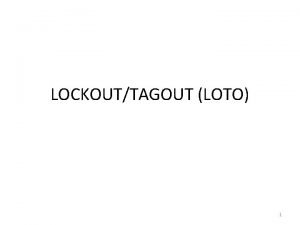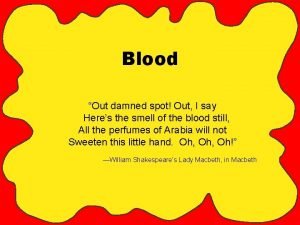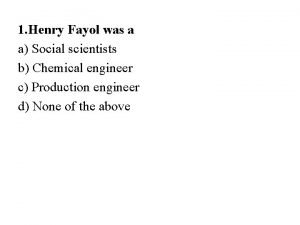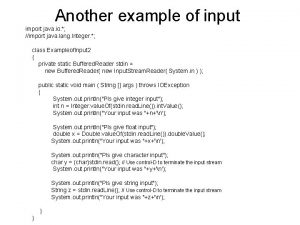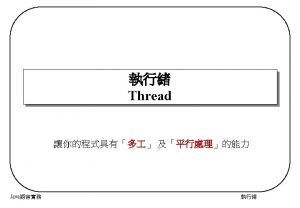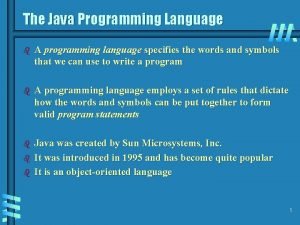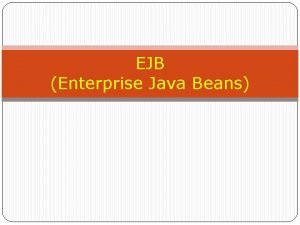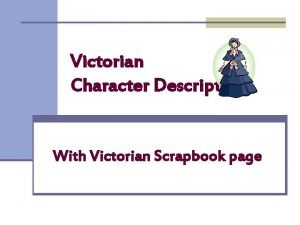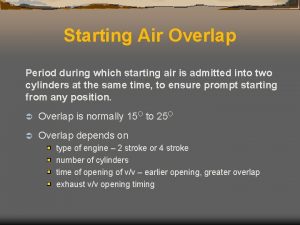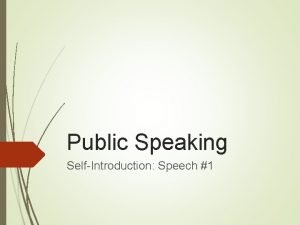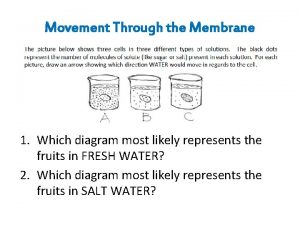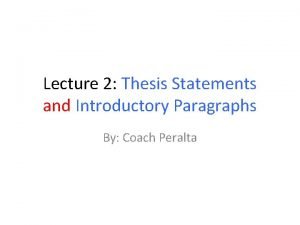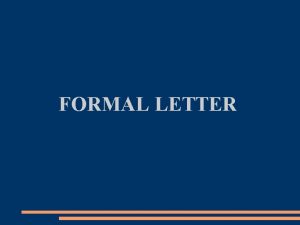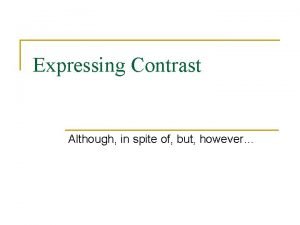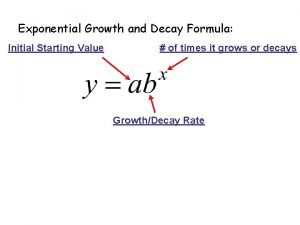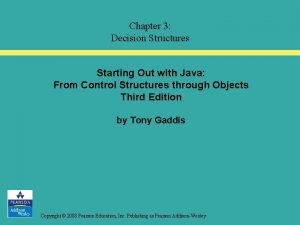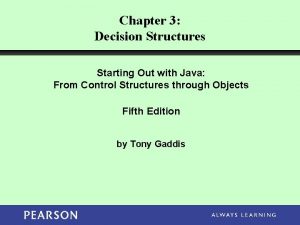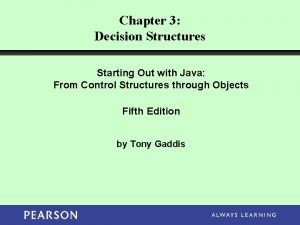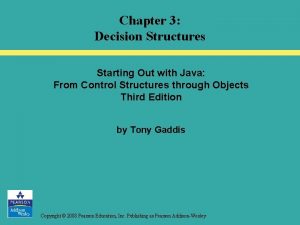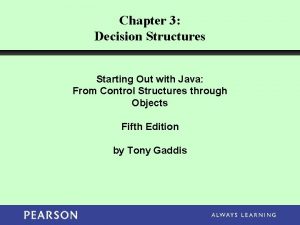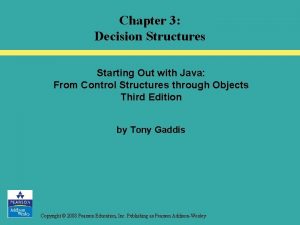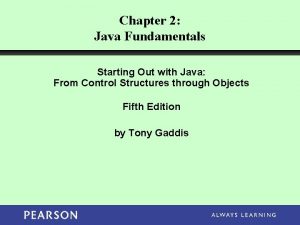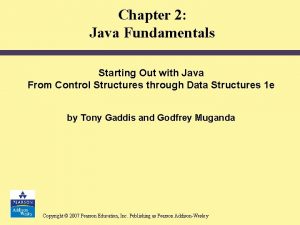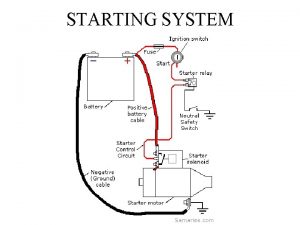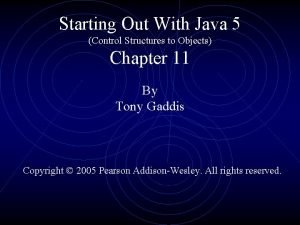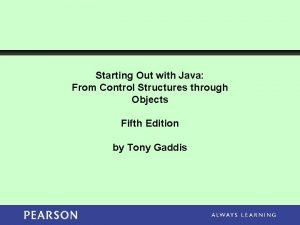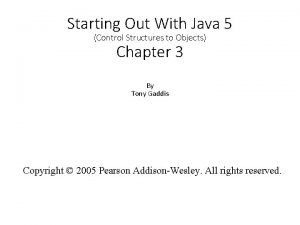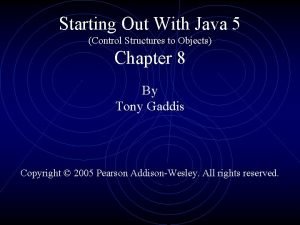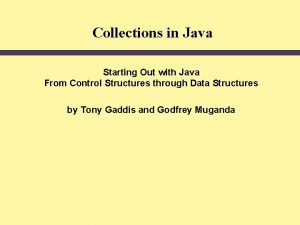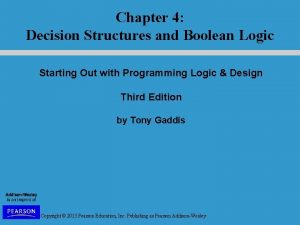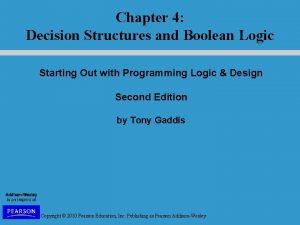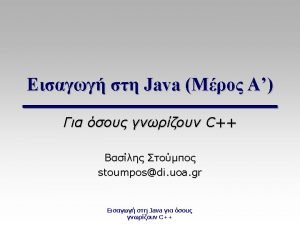Chapter 3 Decision Structures Starting Out with Java
































































- Slides: 64

Chapter 3: Decision Structures Starting Out with Java: From Control Structures through Objects Fifth Edition by Tony Gaddis

Chapter Topics • • • The if Statement The if-else Statement Nested if statements The if-else-if Statement Logical Operators Comparing String Objects Variable Declaration and Scope The Conditional Operator The switch Statement The printf Method The Decimal. Format Class © 2013 Pearson Education, Inc. Upper Saddle River, NJ. All Rights Reserved. 3 -2

The if Statement • The if statement uses a boolean to decide whether the next statement or block of statements executes. if (boolean expression is true) execute next statement. © 2013 Pearson Education, Inc. Upper Saddle River, NJ. All Rights Reserved. 3 -3

Flowcharts • If statements can be modeled as a flow chart. if (cold. Outside) wear. Coat(); Is it cold outside? Yes Wear a coat. © 2013 Pearson Education, Inc. Upper Saddle River, NJ. All Rights Reserved. 3 -4

Flowcharts • A block if statement may be modeled as: if (cold. Outside) { wear. Coat(); wear. Hat(); wear. Gloves(); } Is it cold outside? Yes Wear a coat. Wear a hat. Wear gloves. Note the use of curly braces to block several statements together. © 2013 Pearson Education, Inc. Upper Saddle River, NJ. All Rights Reserved. 3 -5

Relational Operators • In most cases, the boolean expression, used by the if statement, uses relational operators. Relational Operator Meaning > is greater than < is less than >= is greater than or equal to <= is less than or equal to == is equal to != is not equal to © 2013 Pearson Education, Inc. Upper Saddle River, NJ. All Rights Reserved. 3 -6

Boolean Expressions • A boolean expression is any variable or calculation that results in a true or false condition. Expression Meaning x > y Is x greater than y? x < y Is x less than y? x >= y Is x greater than or equal to y? x <= y Is x less than or equal to y. x == y Is x equal to y? x != y Is x not equal to y? © 2013 Pearson Education, Inc. Upper Saddle River, NJ. All Rights Reserved. 3 -7

if Statements and Boolean Expressions if (x > y) System. out. println("X is greater than Y"); if(x == y) System. out. println("X is equal to Y"); if(x != y) { System. out. println("X is not equal to Y"); x = y; System. out. println("However, now it is. "); } Example: Average. Score. java © 2013 Pearson Education, Inc. Upper Saddle River, NJ. All Rights Reserved. 3 -8

Programming Style and if Statements • An if statement can span more than one line; however, it is still one statement. if (average > 95) grade = ′A′; is functionally equivalent to if(average > 95) grade = ′A′; © 2013 Pearson Education, Inc. Upper Saddle River, NJ. All Rights Reserved. 3 -9

Programming Style and if Statements • Rules of thumb: – The conditionally executed statement should be on the line after the if condition. – The conditionally executed statement should be indented one level from the if condition. – If an if statement does not have the block curly braces, it is ended by the first semicolon encountered after the if condition. if (expression) statement; No semicolon here. Semicolon ends statement here. © 2013 Pearson Education, Inc. Upper Saddle River, NJ. All Rights Reserved. 3 -10

Block if Statements • Conditionally executed statements can be grouped into a block by using curly braces {} to enclose them. • If curly braces are used to group conditionally executed statements, the if statement is ended by the closing curly brace. if (expression) { statement 1; statement 2; Curly brace ends the statement. } © 2013 Pearson Education, Inc. Upper Saddle River, NJ. All Rights Reserved. 3 -11

Block if Statements • Remember that when the curly braces are not used, then only the next statement after the if condition will be executed conditionally. if (expression) statement 1; statement 2; statement 3; Only this statement is conditionally executed. © 2013 Pearson Education, Inc. Upper Saddle River, NJ. All Rights Reserved. 3 -12

Flags • A flag is a boolean variable that monitors some condition in a program. • When a condition is true, the flag is set to true. • The flag can be tested to see if the condition has changed. if (average > 95) high. Score = true; • Later, this condition can be tested: if (high. Score) System. out. println("That′s a high score!"); © 2013 Pearson Education, Inc. Upper Saddle River, NJ. All Rights Reserved. 3 -13

Comparing Characters • Characters can be tested with relational operators. • Characters are stored in memory using the Unicode character format. – Unicode is stored as a sixteen (16) bit number. • Characters are ordinal, meaning they have an order in the Unicode character set. – Since characters are ordinal, they can be compared to each other. char c = ′A′; if(c < ′Z′) System. out. println("A is less than Z"); © 2013 Pearson Education, Inc. Upper Saddle River, NJ. All Rights Reserved. 3 -14

if-else Statements • The if-else statement adds the ability to conditionally execute code when the if condition is false. if (expression) statement. Or. Block. If. True; else statement. Or. Block. If. False; • See example: Division. java © 2013 Pearson Education, Inc. Upper Saddle River, NJ. All Rights Reserved. 3 -15

if-else Statement Flowcharts No Is it cold outside? Wear shorts. © 2013 Pearson Education, Inc. Upper Saddle River, NJ. All Rights Reserved. Yes Wear a coat. 3 -16

Nested if Statements • If an if statement appears inside another if statement (single or block) it is called a nested if statement. • The nested if is executed only if the outer if statement results in a true condition. • See example: Loan. Qualifier. java © 2013 Pearson Education, Inc. Upper Saddle River, NJ. All Rights Reserved. 3 -17

Nested if Statement Flowcharts No Yes Is it cold outside? Wear shorts. No Wear a jacket. © 2013 Pearson Education, Inc. Upper Saddle River, NJ. All Rights Reserved. Is it snowing? Yes Wear a parka. 3 -18

Nested if Statements if (cold. Outside) { if (snowing) { wear. Parka(); } else { wear. Jacket(); } } else { wear. Shorts(); } © 2013 Pearson Education, Inc. Upper Saddle River, NJ. All Rights Reserved. 3 -19

if-else Matching • Curly brace use is not required if there is only one statement to be conditionally executed. • However, sometimes curly braces can help make the program more readable. • Additionally, proper indentation makes it much easier to match up else statements with their corresponding if statement. © 2013 Pearson Education, Inc. Upper Saddle River, NJ. All Rights Reserved. 3 -20

Alignment and Nested if Statements This if and else go together. if (cold. Outside) { if (snowing) { wear. Parka(); } else { wear. Jacket(); } } else { wear. Shorts(); } © 2013 Pearson Education, Inc. Upper Saddle River, NJ. All Rights Reserved. 3 -21

if-else-if Statements if (expression_1) { statement; If expression_1 is true these statements are statement; executed, and the rest of the structure is ignored. etc. } else if (expression_2) { statement; Otherwise, if expression_2 is true these statements are statement; executed, and the rest of the structure is ignored. etc. } Insert as many else if clauses as necessary else { statement; These statements are executed if none of the statement; etc. expressions above are true. } © 2013 Pearson Education, Inc. Upper Saddle River, NJ. All Rights Reserved. 3 -22

if-else-if Statements • The if-else-if statement makes certain types of nested decision logic simpler to write. • Nested if statements can become very complex. • Care must be used since else statements match up with the immediately preceding unmatched if statement. • See example: Test. Results. java © 2013 Pearson Education, Inc. Upper Saddle River, NJ. All Rights Reserved. 3 -23

if-else-if Flowchart © 2013 Pearson Education, Inc. Upper Saddle River, NJ. All Rights Reserved. 3 -24

Logical Operators • Java provides two binary logical operators (&& and ||) that are used to combine boolean expressions. • Java also provides one unary (!) logical operator to reverse the truth of a boolean expression. © 2013 Pearson Education, Inc. Upper Saddle River, NJ. All Rights Reserved. 3 -25

Logical Operators Operator && || ! Meaning Effect AND Connects two boolean expressions into one. Both expressions must be true for the overall expression to be true. OR Connects two boolean expressions into one. One or both expressions must be true for the overall expression to be true. It is only necessary for one to be true, and it does not matter which one. NOT The ! operator reverses the truth of a boolean expression. If it is applied to an expression that is true, the operator returns false. If it is applied to an expression that is false, the operator returns true. © 2013 Pearson Education, Inc. Upper Saddle River, NJ. All Rights Reserved. 3 -26

The && Operator • The logical AND operator (&&) takes two operands that must both be boolean expressions. • The resulting combined expression is true if (and only if) both operands are true. • See example: Logical. And. java Expression 1 Expression 2 Expression 1 && Expression 2 true false false true © 2013 Pearson Education, Inc. Upper Saddle River, NJ. All Rights Reserved. 3 -27

The || Operator • The logical OR operator (||) takes two operands that must both be boolean expressions. • The resulting combined expression is false if (and only if) both operands are false. • Example: Logical. Or. java Expression 1 Expression 2 Expression 1 || Expression 2 true false false true © 2013 Pearson Education, Inc. Upper Saddle River, NJ. All Rights Reserved. 3 -28

The ! Operator • The ! operator performs a logical NOT operation. • If an expression is true, !expression will be false. if (!(temperature > 100)) System. out. println("Below the maximum temperature. "); • If temperature > 100 evaluates to false, then the output statement will be run. Expression 1 !Expression 1 true false true © 2013 Pearson Education, Inc. Upper Saddle River, NJ. All Rights Reserved. 3 -29

Short Circuiting • Logical AND and logical OR operations perform short-circuit evaluation of expressions. • Logical AND will evaluate to false as soon as it sees that one of its operands is a false expression. • Logical OR will evaluate to true as soon as it sees that one of its operands is a true expression. © 2013 Pearson Education, Inc. Upper Saddle River, NJ. All Rights Reserved. 3 -30

Order of Precedence • The ! operator has a higher order of precedence than && and the && operator has higher precedence than the|| operator. • In general, the arithmetic operators have higher precedence than the relational operators. And, the relational operators have higher precedence than the logical operators. • Parenthesis can be used to force the precedence to be changed. © 2013 Pearson Education, Inc. Upper Saddle River, NJ. All Rights Reserved. 3 -31

Order of Precedence 1 Operators Description (unary negation) ! Unary negation, logical NOT 2 * / % 3 + - 4 < > <= >= 5 == != 6 && Logical AND 7 || Logical NOT 8 = += -= *= /= %= Multiplication, Division, Modulus Addition, Subtraction Less-than, Greater-than, Less-than or equal to, Greater-than or equal to Is equal to, Is not equal to Assignment and combined assignment operators. © 2013 Pearson Education, Inc. Upper Saddle River, NJ. All Rights Reserved. 3 -32

Comparing String Objects • In most cases, you cannot use the relational operators to compare two String objects. • Reference variables contain the address of the object they represent. • Unless the references point to the same object, the relational operators will not return true. • See example: String. Compare. java • See example: String. Compare. To. java © 2013 Pearson Education, Inc. Upper Saddle River, NJ. All Rights Reserved. 3 -33

Ignoring Case in String Comparisons • In the String class the equals and compare. To methods are case sensitive. • In order to compare two String objects that might have different case, use: – equals. Ignore. Case, or – compare. To. Ignore. Case • See example: Secret. Word. java © 2013 Pearson Education, Inc. Upper Saddle River, NJ. All Rights Reserved. 3 -34

Variable Scope • In Java, a local variable does not have to be declared at the beginning of the method. • The scope of a local variable begins at the point it is declared and terminates at the end of the method. • When a program enters a section of code where a variable has scope, that variable has come into scope, which means the variable is visible to the program. • See example: Variable. Scope. java © 2013 Pearson Education, Inc. Upper Saddle River, NJ. All Rights Reserved. 3 -35

The Conditional Operator • The conditional operator is a ternary (three operand) operator. • You can use the conditional operator to write a simple statement that works like an if-else statement. © 2013 Pearson Education, Inc. Upper Saddle River, NJ. All Rights Reserved. 3 -36

The Conditional Operator • The format of the operators is: Boolean. Expression ? Value 1 : Value 2 • This forms a conditional expression. • If Boolean. Expression is true, the value of the conditional expression is Value 1. • If Boolean. Expression is false, the value of the conditional expression is Value 2. © 2013 Pearson Education, Inc. Upper Saddle River, NJ. All Rights Reserved. 3 -37

The Conditional Operator • Example: z = x > y ? 10 : 5; • This line is functionally equivalent to: if(x > y) z = 10; else z = 5; © 2013 Pearson Education, Inc. Upper Saddle River, NJ. All Rights Reserved. 3 -38

The Conditional Operator • Many times the conditional operator is used to supply a value. number = x > y ? 10 : 5; • This is functionally equivalent to: if(x > y) number = 10; else number = 5; • See example: Consultant. Charges. java © 2013 Pearson Education, Inc. Upper Saddle River, NJ. All Rights Reserved. 3 -39

The switch Statement • The if-else statement allows you to make true / false branches. • The switch statement allows you to use an ordinal value to determine how a program will branch. • The switch statement can evaluate an integer type or character type variable and make decisions based on the value. © 2013 Pearson Education, Inc. Upper Saddle River, NJ. All Rights Reserved. 3 -40

The switch Statement • The switch statement takes the form: switch (Switch. Expression) { case Case. Expression: // place one or more statements here break; // case statements may be repeated //as many times as necessary default: // place one or more statements here } © 2013 Pearson Education, Inc. Upper Saddle River, NJ. All Rights Reserved. 3 -41

The switch Statement switch (Switch. Expression) { … } • The switch statement will evaluate the Switch. Expression, which can be a byte, short, int, long, or char. If you are using Java 7, the Switch. Expression can also be a string. • If there is an associated case statement that matches that value, program execution will be transferred to that case statement. © 2013 Pearson Education, Inc. Upper Saddle River, NJ. All Rights Reserved. 3 -42

The switch Statement • Each case statement will have a corresponding Case. Expression that must be unique. case Case. Expression: // place one or more statements here break; • If the Switch. Expression matches the Case. Expression, the Java statements between the colon and the break statement will be executed. © 2013 Pearson Education, Inc. Upper Saddle River, NJ. All Rights Reserved. 3 -43

The case Statement • The break statement ends the case statement. • The break statement is optional. • If a case does not contain a break, then program execution continues into the next case. – See example: No. Breaks. java – See example: Pet. Food. java • The default section is optional and will be executed if no Case. Expression matches the Switch. Expression. • See example: Switch. Demo. java © 2013 Pearson Education, Inc. Upper Saddle River, NJ. All Rights Reserved. 3 -44

The printf Method • You can use the System. out. printf method to performatted console output. • The general format of the method is: System. out. printf(Format. String, Arg. List); © 2013 Pearson Education, Inc. Upper Saddle River, NJ. All Rights Reserved. 3 -45

The printf Method System. out. printf(Format. String, Arg. List); Format. String is a string that contains text and/or special formatting specifiers. Arg. List is optional. It is a list of additional arguments that will be formatted according to the format specifiers listed in the format string. © 2013 Pearson Education, Inc. Upper Saddle River, NJ. All Rights Reserved. 3 -46

The printf Method • A simple example: System. out. printf("Hello Worldn"); © 2013 Pearson Education, Inc. Upper Saddle River, NJ. All Rights Reserved. 3 -47

The printf Method • Another example: int hours = 40; System. out. printf("I worked %d hours. n", hours); © 2013 Pearson Education, Inc. Upper Saddle River, NJ. All Rights Reserved. 3 -48

The printf Method int hours = 40; System. out. printf("I worked %d hours. n", hours); The %d format specifier indicates that a decimal integer will be printed. The contents of the hours variable will be printed in the location of the %d format specifier. © 2013 Pearson Education, Inc. Upper Saddle River, NJ. All Rights Reserved. 3 -49

The printf Method • Another example: int dogs = 2, cats = 4; System. out. printf("We have %d dogs and %d cats. n", dogs, cats); © 2013 Pearson Education, Inc. Upper Saddle River, NJ. All Rights Reserved. 3 -50

The printf Method • Another example: double gross. Pay = 874. 12; System. out. printf("Your pay is %f. n", gross. Pay); © 2013 Pearson Education, Inc. Upper Saddle River, NJ. All Rights Reserved. 3 -51

The printf Method • Another example: double gross. Pay = 874. 12; System. out. printf("Your pay is %f. n", gross. Pay); The %f format specifier indicates that a floating-point value will be printed. The contents of the gross. Pay variable will be printed in the location of the %f format specifier. © 2013 Pearson Education, Inc. Upper Saddle River, NJ. All Rights Reserved. 3 -52

The printf Method • Another example: double gross. Pay = 874. 12; System. out. printf("Your pay is %. 2 f. n", gross. Pay); © 2013 Pearson Education, Inc. Upper Saddle River, NJ. All Rights Reserved. 3 -53

The printf Method • Another example: double gross. Pay = 874. 12; System. out. printf("Your pay is %. 2 f. n", gross. Pay); The %. 2 f format specifier indicates that a floating-point value will be printed, rounded to two decimal places. © 2013 Pearson Education, Inc. Upper Saddle River, NJ. All Rights Reserved. 3 -54

The printf Method • Another example: double gross. Pay = 5874. 127; System. out. printf("Your pay is %, . 2 f. n", gross. Pay); The %, . 2 f format specifier indicates that a floatingpoint value will be printed with comma separators, rounded to two decimal places. © 2013 Pearson Education, Inc. Upper Saddle River, NJ. All Rights Reserved. 3 -55

The printf Method • Another example: String name = "Ringo"; System. out. printf("Your name is %s. n", name); The %s format specifier indicates that a string will be printed. © 2013 Pearson Education, Inc. Upper Saddle River, NJ. All Rights Reserved. 3 -56

The printf Method • Specifying a field width: int number = 9; System. out. printf("The value is %6 dn", number); The %6 d format specifier indicates the integer will appear in a field that is 6 spaces wide. © 2013 Pearson Education, Inc. Upper Saddle River, NJ. All Rights Reserved. 3 -57

The printf Method • Another example: double number = 9. 76891; System. out. printf("The value is %6. 2 fn", number); The %6. 2 f format specifier indicates the number will appear in a field that is 6 spaces wide, and be rounded to 2 decimal places. © 2013 Pearson Education, Inc. Upper Saddle River, NJ. All Rights Reserved. 3 -58

The printf Method • See examples: – Columns. java – Currency. Format. java © 2013 Pearson Education, Inc. Upper Saddle River, NJ. All Rights Reserved.

The Decimal. Format Class • When printing out double and float values, the full fractional value will be printed, which is usually more than what we need. – 15 digits for double – 6 digits for float • The Decimal. Format class can be used to format these values. • In order to use the Decimal. Format class, the following import statement must be used at the top of the program: import java. text. Decimal. Format; • See examples: Format 1. java, Format 2. java, Format 3. java, Format 4. java © 2013 Pearson Education, Inc. Upper Saddle River, NJ. All Rights Reserved. 3 -60

The Decimal. Format Class • To use the Decimal. Format class, you create an object: Decimal. Format formatter = new Decimal. Format(“#0. 00”); “#0. 00” is called a format pattern, where each character in the format pattern corresponds with a position in a number. # a single digit (if no digit at that position, nothing shown) 0 a single digit (if no digit at that position, 0 will be displayed) . 00 display 2 digits after decimal point Note that if the number of characters before the decimal point is not enough size to display to value, Java will automatically expand the area. © 2013 Pearson Education, Inc. Upper Saddle River, NJ. All Rights Reserved. 3 -61

The Decimal. Format Class • If format pattern is “#0. 00” 0. 1666 will be displayed as 0. 17 166. 6666 will be displayed as 166. 67 • If format pattern is “#. 00” 0. 1666 will be displayed as. 17 166. 6666 will be displayed as 166. 67 • If format pattern is “ 000. 00” 0. 1666 will be displayed as 000. 17 166. 6666 will be displayed as 166. 67 © 2013 Pearson Education, Inc. Upper Saddle River, NJ. All Rights Reserved. 3 -62

The Decimal. Format Class • Now call the format method on the Decimal. Format object and pass the number you want to format as a parameter. double n 1 = 0. 1666; double n 2 = 1. 666; double n 3 = 16. 666; double n 4 = 166. 666; System. out. println(formatter. format(n 1)); System. out. println(formatter. format(n 2)); System. out. println(formatter. format(n 3)); System. out. println(formatter. format(n 4)); © 2013 Pearson Education, Inc. Upper Saddle River, NJ. All Rights Reserved. 3 -63

The Decimal. Format Class • If format pattern is “#, ##0. 00” with grouping separator 123. 899 will be displayed as 123. 90 1233. 899 will be displayed as 1, 233. 90 1234567. 899 will be displayed as 1, 234, 567. 90 • If format pattern is “$#, ##0. 00” with $ at the beginning of the pattern 12345. 67 will be displayed as $12, 345. 67 • If format pattern is “ 0%” with % at the end of the pattern 0. 12 will be displayed as 12% 0. 05 will be displayed as 5% 0. 005 will be displayed as 0% © 2013 Pearson Education, Inc. Upper Saddle River, NJ. All Rights Reserved. 3 -64
 Objectives of decision making
Objectives of decision making Financial management process
Financial management process One direction shot me out of the sky
One direction shot me out of the sky Analogous structures
Analogous structures Nested decision structures in python
Nested decision structures in python Two way decision python
Two way decision python Chapter 30 engine starting systems
Chapter 30 engine starting systems Chapter 4 performing basic maneuvers worksheet answers
Chapter 4 performing basic maneuvers worksheet answers Chapter 6 entrepreneurship and starting a small business
Chapter 6 entrepreneurship and starting a small business Chapter 6 entrepreneurship and starting a small business
Chapter 6 entrepreneurship and starting a small business Chapter 6 entrepreneurship and starting a small business
Chapter 6 entrepreneurship and starting a small business Chapter 1 starting a proprietorship
Chapter 1 starting a proprietorship Entrepreneurship chapter 6
Entrepreneurship chapter 6 Decision tree and decision table
Decision tree and decision table Advanced data structures in java
Advanced data structures in java Dynamic data structure in java
Dynamic data structure in java Data structures and abstractions with java
Data structures and abstractions with java Java software structures 4th edition
Java software structures 4th edition Singly linked list in data structure
Singly linked list in data structure Data structures in java
Data structures in java Data structures in java
Data structures in java Stacks in data structures
Stacks in data structures Binary search tree java
Binary search tree java Data structures using java
Data structures using java Othello put out the light
Othello put out the light Out, out— robert frost
Out, out— robert frost Out of sight out of mind quotes
Out of sight out of mind quotes Allusion in out out by robert frost
Allusion in out out by robert frost Lock out tag out safety talk
Lock out tag out safety talk Out out robert frost analysis
Out out robert frost analysis Out of sight out of time
Out of sight out of time Matthew 11 28-30 message
Matthew 11 28-30 message Lock out tag out pictures
Lock out tag out pictures Out, damned spot! out, i say!
Out, damned spot! out, i say! Henri fayol was a social scientist
Henri fayol was a social scientist Makna out of sight out of mind
Makna out of sight out of mind Bgsu quality systems
Bgsu quality systems Java number
Java number Java import java.util.*
Java import java.util.* Import java.awt.*
Import java.awt.* Import java.util.*
Import java.util.* Java 讀檔
Java 讀檔 Java import java.util.*
Java import java.util.* Import java.util.random
Import java.util.random Import java.io.* in java
Import java.io.* in java Import.java.util.*
Import.java.util.* Java import java.io.*
Java import java.io.* Perbedaan awt dan swing
Perbedaan awt dan swing Import java.awt.* import java.awt.event.*
Import java.awt.* import java.awt.event.* Java interpreter
Java interpreter Rmi vs ejb
Rmi vs ejb Thinking of starting a business
Thinking of starting a business Victorian scrapbook
Victorian scrapbook Zahed siddique
Zahed siddique Three phase synchronous generator
Three phase synchronous generator Overlap in starting air system
Overlap in starting air system Presentation starting speech
Presentation starting speech Starting and derived positions
Starting and derived positions Photosynthesis recipe card
Photosynthesis recipe card Tag writing examples
Tag writing examples Funnel style introduction
Funnel style introduction Formal letter rules
Formal letter rules However but although nevertheless
However but although nevertheless Population growth formula
Population growth formula Sturdt
Sturdt




